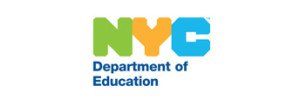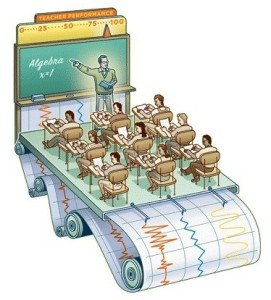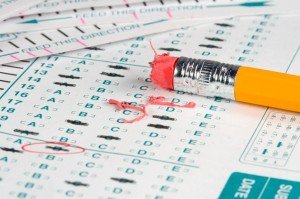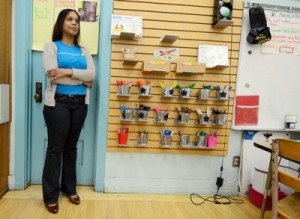Articles
STATE SETS NEW DEADLINE IN NYC TEACHER PLAN TUSSLE (ABSTRACT)
By Carolyn Thompson, Associated Press – updated 5:07 pm, Friday, January 18, 2013
Under New York State law, 20 percent of teacher evaluations must be based on students’ growth on state tests. Another 20 percent must be based on local measures and the remaining 60 percent  must include classroom observations and can also include parent or student surveys.
must include classroom observations and can also include parent or student surveys.
“Principals have not been trained; teachers at schools have not been trained. They have not developed the necessary options for some of the measures of student performance and that’s essential,” New York City Education Commissioner John King said. “The longer they wait to prepare, the longer students will wait for the evaluation system that’s needed.”
AS STATE WATCHES, LA UNIFIED TESTS NEW WAYS TO GRADE TEACHERS
By Ashly McGlone
Center for Investigative Reporting June 3, 2013
LOS ANGELES – Robin Wynne Davis was taken aback last year when the state test score gains of her third-grade students at Melrose Elementary School labeled her a less-than-stellar teacher. “I am just an average teacher, according to that data, but if you look at my class and see how many children are proficient and advanced, it’s a lot of kids,” said Wynne Davis, now an instructional support coach for Melrose Elementary in central Los Angeles.
Seeing her assessment as an “average” teacher in English and a “more effective than average” teacher in math hit the Los Angeles Times a few years ago was upsetting and embarrassing, she said. The assessment of her teaching was based in part on her 2010 students’ test scores.
Sachiko Miyaji was one of five teachers in the pilot evaluation program last year at Melrose Elementary School. She said student test scores don’t measure the vibrancy of what’s happening in the classroom. “I think we have to be judged by how well the kids do in our classrooms, because that’s the nature of teaching. What I don’t like is it doesn’t seem fair,” she said.
Nowhere else in California has the debate over the use of student test scores to grade teachers gained more attention than in the Los Angeles Unified School District. The second-largest school district in the nation at more than 640,000 students, Los Angeles Unified has become a testing ground to increase accountability for teachers, a movement that has gained speed across the nation.
The hope is that schools will improve student achievement by better identifying which teachers are excelling, which are struggling and which need to be removed from the classroom altogether. The outcome in Los Angeles will have repercussions throughout the state, as pressure mounts to improve the state’s lagging achievement and qualify for federal funding.
The district – propelled by a lawsuit and led by Superintendent John Deasy, a darling of reformers who support the effort to overhaul teacher evaluations – has pushed to use mathematical algorithms known as value-added measurement to provide what proponents say is more precise quantitative information about a teacher’s performance. The local union, United Teachers Los Angeles, has fought back furiously and argued against any cookie-cutter approaches.
The two sides have made an uneasy compromise that has not eliminated potential problems that can arise from attributing a student’s performance on a test to a teacher’s abilities. A deal ratified earlier this year allows the district to use state test scores and the Academic Growth Over Time measurement, which includes past test scores and demographics like family income, language and ethnicity. The deal specifically prohibits the use of individual teacher growth scores other than to “give perspective and to assist in reviewing the past CST (California Standards Test) results of the teacher.”
Critically, however, the agreement is silent on how much weight student data has. An announcement by Deasy in February that student data could account for up to 30 percent of a teacher’s evaluation was met with mixed responses.
Warren Fletcher, president of the 36,000-member United Teachers Los Angeles union, argued that the percentage violates the deal made with the union. It launched an offensive, equipping members with a “Teacher Evaluation Rights Toolkit.” Included was an objection letter to give to principals and examples of what the union said were permissible additions to this year’s initial evaluation planning sheets. “We negotiated an agreement that honors the concept that administrators and teachers are adults and need to have an amount of discretion in how this works,” said Fletcher, who is in his second year as president of the union.
Despite her experience with the “Academic Growth over Time” results, teacher Wynne Davis at Melrose Elementary said she welcomes the capped percentage, which allows for various types of student data.
“I don’t understand why anybody would be upset with 30 percent of your evaluation being tied to student achievement; that means 70 percent is not,” she said. “We are teachers, for God’s sake. I mean, how are you supposed to be judged if you are not using the kids’ work?”
New teacher evaluations
Although the use of test scores remains the most controversial piece of the evaluations, it remains to beseen how the main portion of the evaluations, which are based on intensive, time-consuming qualitative measures of a teacher’s performance, will affect schools and classrooms. Los Angeles Unified began testing changes to the teacher evaluation system last school year with 425 teachers at 100 campuses who elected to participate and provide feedback.
This year, LAUSD’s pilot program was expanded to more than 1,100 school-site administrators who are working to fine-tune changes with about 900 teachers, one at each campus in the district. In the pilot, state test score gains in a particular class were analyzed and scored relative to the student’s predicted growth based on past scores, and relative to the average gains seen across the district and within different groups of the student population. But the main focus of the pilot was to test the new qualitative measures.
Lengthy and more detailed evaluation score sheets are given to teachers for self-assessment and principals for observations. What was once a four-page evaluation is now 26 pages with descriptions of what an “ineffective,” “developing,” “effective” and “highly effective” teacher looks like in 61 areas; based on participant feedback, the district limited reviews to 21 areas this year.
Principals also are required to write exactly what they see and hear in the classroom as evidence and rationale of the teacher’s evaluation, a requirement that can leave observers tied to their computers and unable to take in the entire class experience, several pilot participants said. Because principals are working with one teacher as a part of the pilot, it’s unclear what the burden will be when they have to observe all of their teachers when the new system rolls out.
computers and unable to take in the entire class experience, several pilot participants said. Because principals are working with one teacher as a part of the pilot, it’s unclear what the burden will be when they have to observe all of their teachers when the new system rolls out.
The pilot also tried to address the tricky issue of how to provide student achievement measures for the vast majority of teachers of grades and subjects that are not tested on a state exam, including physical education and art. For now, those teachers, particularly in the early grades, must cobble together a variety of measurements to give some sense of their performance.
At Melrose, veteran teacher Sachiko Miyaji is in her 17th year teaching. She and Wynne Davis were among five teachers at the math, science and technology magnet campus last year to volunteer for the pilot program. The addition of the hotly contested student test scores in the pilot didn’t affect Miyaji because students take their first California Standards Test in the second grade. As such, the district can’t issue her and other second-grade teachers the “individual Academic Growth over Time” scores it has been issuing since spring 2011.
Without state test score gains available, Miyaji relied on other student data for her evaluation. She included her students’ scores on district literacy tests and the University of Oregon’s “Dynamic Indicators of Basic Early Literacy Skills” (DIBELS tests), given three times a year at 20 percent of elementary schools in the nation. But she said none of that measures the vibrancy of what’s actually happening in the classroom.
On a sunny Friday morning in March, Miyaji gathered her second-graders on the carpet at the front of the class for a lesson on lions and tigers. “Did you know the back feet of lions and tigers have only four toes?” Miyaji asked. “So which feet? The front or the back?” Her students, a rambunctious group of 7- and 8-year-olds, respond in unison, “The back!” Reading from a book, Miyaji told her students that lion prides typically include two dozen cubs. “That’s 24! Twenty-four cubs,” one student shouted. “How do you know it is 24, Carlos?” Miyaji asked. “Because a dozen is 12,” Carlos said.
Its observations like this that many teachers hope will provide a clearer picture of their classrooms and make up for any deficiencies in using test scores to judge their performance.
Examining student test scores
Nationally, experts have disputed whether student test score data can be used reliably to measure teacher performance – but nearly all agree that such data should be coupled with more qualitative information to ensure fairness and make sure the evaluations are useful to teachers.
Proponents say the test data is appropriate because it’s one way to measure what’s supposed to be the ultimate outcome of teaching – whether students are learning. The data also can provide a counterweight to principals’ observations, which, depending on how they’re structured, also can have reliability problems. States and districts mostly have opted to look at student growth, as opposed to raw test scores, because raw scores can disadvantage teachers with large numbers of low-income, limited-English or special needs students, who tend to score lower on standardized tests.
Critics of growth measures have said they can fluctuate depending on the variables and number of years of testing data added to the mathematical formula, making their validity suspect, and worry that grading teachers based on tests will cause them to focus more on test prep in their classrooms.
Drew Furedi, formerly the executive director of Los Angeles Unified’s talent management division and now its executive director of human capital initiatives, said the piloted changes focus on evaluation as “a growth and development tool rather than a punitive tool,” which will tie results to “aligned, targeted, professional development opportunities for teachers.” In a letter to teachers May 24, Deasy said the district will fully implement the evaluation changes tested in the pilot program next school year.
evaluation as “a growth and development tool rather than a punitive tool,” which will tie results to “aligned, targeted, professional development opportunities for teachers.” In a letter to teachers May 24, Deasy said the district will fully implement the evaluation changes tested in the pilot program next school year.
There’s another reason for the district to be motivated. Los Angeles Unified hopes to opt out of federal student accountability sanctions coming its way in 2014 under the No Child Left Behind Act. The Obama administration offered waivers from the law’s requirement that states steadily increase the number of students graded proficient on standardized exams to 37 states that agreed to other accountability measures, including new evaluations for teachers and principals.
With the promise of local accountability and coordinated efforts to improve, the district is one of nine in a consortium called the California Office to Reform Education – which includes Oakland, Sacramento and San Francisco – seeking a waiver from the U.S. Department of Education. If approved, it would be the first district-level waiver obtained in the offer intended for states.
Other districts and states also have responded to the Obama administration’s urging – through No Child Left Behind waivers and grant competitions like Race to the Top – that districts and states overhaul their evaluations. According to a review by the National Council on Teacher Quality, a Washington, D.C.-based reform group, 20 states in 2012 required student achievement as a significant part of judging teacher performance, including multiple states where student data accounts for 50 percent of an evaluation. In 2009, four states required student data in a significant way.
In many of those places, policymakers have encountered similar resistance from unions and educators on the front lines. Teacher Denise Casco at Vista del Valle Dual Language Academy in San Fernando said the inclusion of student achievement could disproportionately affect her because she serves a more disadvantaged community than others in the district. She said she worries her students are more likely to lag behind on tests. Nearly all 500 students on campus in the far northern part of the district are socioeconomically disadvantaged, and half are English-language learners.
“The playing field is not even,” said Casco, who is in her ninth year of teaching. “The funding is not even; the level of support is not even. So I am very cautious at putting a number or percentage for a particular level of student achievement in a teacher evaluation process.” But not all of the changes are concerning, she said. Like many teachers around the country, she has embraced the more intensive classroom observations, which tend to offer teachers more specific feedback than previous versions.
As a kindergarten teacher last year who participated in the pilot program, Casco had a videotaped math lesson that was selected by the district as a model to train administrators on what to look for during an observation. In it, her 5- and 6-year-old students are working in small groups. Students play a series of games related to frogs and fish to practice adding and subtracting and eventually are asked to illustrate a story with an equation and grade their own performance on a rubric.
“It forces you to reflect,” Casco said of the evaluation changes, which include the principal asking teachers after the observation if they achieved their objective. “It did hold me more accountable to the results than the old evaluation system would have.”
Lawsuit seeks to strike some teacher protections
The fight in Los Angeles has had a ripple effect across the state. Student plaintiffs filed a lawsuit last May against the state of California and several local districts, including Los Angeles Unified. The lawsuit aims to increase the impact of teacher evaluations by striking down multiple protections teachers have under the law.
Represented by Los Angeles law firm Gibson, Dunn & Crutcher LLP, the plaintiffs allege teacher protections such as tenure, seniority rules in layoffs and other teacher dismissal statutes disparately keep ineffective teachers in the classroom in violation of the state constitution’s equal protection clause. The case also cites court opinions that have held that “the right to an education today means more than access to a classroom” and that the state “has broad responsibility to ensure basic educational equality.”
keep ineffective teachers in the classroom in violation of the state constitution’s equal protection clause. The case also cites court opinions that have held that “the right to an education today means more than access to a classroom” and that the state “has broad responsibility to ensure basic educational equality.”
Deasy and Xavier De La Torre, Santa Clara County’s superintendent of schools, have endorsed the case, according to the nonprofit Students Matter, the advocacy group sponsoring the lawsuit. After failed efforts by the state to get the case dismissed in the last year, a judge granted a request by the California Teachers Association and the California Federation of Teachers to join the lawsuit as defendants May 2. A trial date is set for Jan. 27, 2014.
Los Angeles Unified parent Lauren Campbell has a child plaintiff in the case and said that even though efforts are underway to overhaul the evaluation system in the district, it won’t do much to protect effective, less-senior teachers who she says she has seen get layoff notices year after year at Lanai Road Elementary School in Encino. “I think that if we value education and we say we want great teachers for our kids, we need to make that job attractive, and part of the way to do that is not fire the best ones every year,” Campbell said.
Los Angeles Unified parent Lisa Liss also argues that the layoff system targets great teachers over less effective ones. “The impact of having a really bad teacher goes way beyond one academic year. Those kids end up behind for years to come and maybe even permanently,” she said, “so every child should have a great teacher.”
Liss said you have to go to the top to get the wide-reaching changes needed. “Individual changes will take forever,” she said. “To make a wholesale change at a much higher level is going to be much more effective and much quicker, and these kids don’t have much time to waste. Their education is happening now, not in 20 years.”
Ashly McGlone produced this story for The Hechinger Report and The Center for Investigative Reporting. Sarah Garland of The Hechinger Report contributed to this report.
LONG-NEGLECTED LAW ON TEACHER EVALUATIONS RISES TO FOREFRONT
By Ashly McGlone
Center for Investigative Reporting – 6/3/2013
LOS ANGELES – The road to an agreement on teacher evaluations has been a long and costly one that is not yet finished. But recent litigation has put the Los Angeles Unified School District on a fast track. The spotlight on teacher evaluations widened last June when Los Angeles County Superior Court Judge James Chalfant ruled that the district was violating California’s longstanding teacher evaluation law, the Stull Act, by not ensuring test scores were used.
The 1971 law, signed by then-Gov. Ronald Reagan and named after a former Republican lawmaker, requires student achievement to be included in teacher evaluations – something Los Angeles Unified, and most districts, resisted for decades. Some districts found they didn’t need to fully comply with the Stull Act to receive millions of dollars from the state designated for linking teacher evaluations to student achievement.
Melrose Elementary teachers and its principal, Bernadette Lucas, took part in Los Angeles Unified School District’s pilot teacher evaluation program, which factored in student achievement to determine teacher effectiveness. The law was amended in 1999 under Gov. Gray Davis, requiring school boards to evaluate teachers based on state test scores as they “reasonably relate” to a teacher’s classroom performance, a vague term that effectively made it easy for districts to avoid the law.
Now, the little-known Stull Act is having its day after more than 40 years of virtual neglect. The recent case, Doe v. Deasy, was filed in 2010 by several students in the district and sponsored by EdVoice, the nonprofit education reform group backed by billionaire Eli Broad, Netflix CEO Reed Hastings and Richard Merkin, CEO of the Heritage Provider Network, among others.
Chalfant ordered the district to negotiate the terms of test score use with the teachers’ union. All told, the case and bargaining have cost the district more than $418,000 in legal bills to date, district officials said, not including $550,000 in attorney’s fees paid to the plaintiffs. Los Angeles Unified officials were not displeased with the outcome. The ruling served as an endorsement of the district’s efforts to include student test scores in teacher evaluations. The local union, which has had an acrimonious relationship with the Los Angeles administration, also won something it had been seeking: a voice in the matter.
The judge “was actually causing to happen something we had wanted to have happen for a long time, which is that the teachers and the school board slash administration were in the same room talking about what a system would look like,” said Warren Fletcher, president of the 36,000-member United Teachers Los Angeles union. The union had opposed the district’s effort to test changes to the system without negotiating the changes in teacher workload that came with it, and it unsuccessfully sought an injunction from the state Public Employment Relations Board to stop the program in 2011.
Following Chalfant’s ruling, the two parties spent months negotiating before reaching a tentative deal in November, ratified earlier this year. By next year, Los Angeles will comply with the intentions of the four-decade-old law. The deal allows for state test scores and the “Academic Growth Over Time” measurement, which includes past test scores and demographics like students’ family income, language and ethnicity. But the deal specifically prohibits the use of individual teacher growth scores other than to “give perspective and to assist in reviewing the past CST (California Standards Test) results of the teacher.”
of the four-decade-old law. The deal allows for state test scores and the “Academic Growth Over Time” measurement, which includes past test scores and demographics like students’ family income, language and ethnicity. But the deal specifically prohibits the use of individual teacher growth scores other than to “give perspective and to assist in reviewing the past CST (California Standards Test) results of the teacher.”
Critically, however, the agreement is silent on how much weight student data has. Los Angeles Unified Superintendent John Deasy has said it should account for up to 30 percent of a teacher’s evaluation; the union responded by saying such a “cookie-cutter” approach violates its agreement with the district.
Although a judge found Los Angeles Unified out of compliance with the Stull Act last summer, the district had received nearly $8.5 million in funds from the state for costs related to compliance with the law dating back to the 1997-98 school year, state records show. Since 2004, school districts in California have been eligible to obtain certain reimbursements from the state controller’s office for enforcing the Stull Act dating back to 1997. Reimbursable costs include time spent reviewing a teacher’s California Standards Test scores and providing a written performance assessment based on the scores for legally required evaluations.
The flow of money has been unreliable. To date, the state controller’s office has received $236.3 million in Stull Act claims, but not enough funding has been appropriated by the Legislature each year to pay them. One-quarter of the claims for work through the 2010-11 school year have been reimbursed, state data shows.
But the claims from some districts have proved to be suspect. Eleven years of Stull Act claims, totaling almost $1.3 million, were audited in the Oceanside Unified School District in 2011; $16,536 was found to be allowable. The controller disallowed eight years of staff time claims because the district refused to produce sufficient backup documentation. Locating the documents now “would be a significant drain on district resources, staff and funds,” Oceanside district staff wrote. The audit also noted that district was not using state test scores in teacher evaluations during the 11-year period reviewed and that the district’s contract with the teachers union at the time did not allow for it.
The Rowland Unified School District, roughly 30 miles east of Los Angeles, also came up short in its 2010 Stull Act claims audit, public records show. Out of the $2.9 million in reimbursements submitted in the nine years from 1997 to 2006, less than $683,000 was valid, the controller found, primarily due to a lack of supporting documentation. Los Angeles Unified filed its first Stull Act claim in five years in February. The district is seeking $599,222 in reimbursements for principal and assistant principal staff time spent on evaluations last year, records show.
Alternative reform efforts
Although the Stull Act, and the money that has traditionally flowed from it, has been largely unsuccessful in pressuring California districts to adopt evaluations that measure teacher quality by the performance of their students, recent federal efforts have had more success. The Obama administration has used federal money for the Teacher Incentive Fund, Race to the Top and School Improvement Grant program to encourage policymakers in states and districts to adopt new teacher evaluations that incorporate student test scores, despite the controversy surrounding them.
And now, the U.S. Department of Education has taken advantage of the threat of upcoming sanctions for schools and districts that don’t meet student proficiency targets under the federal No Child Left Behind law to extract agreements from states that they will overhaul their evaluations and attach them to student growth. Places that agree to make changes can receive waivers from the law’s requirements – and ensure that the federal funds, upon which many depend, including Title I, will continue to flow. Thirty-seven states and the District of Columbia have had waivers approved. Nine other states are under review.
Los Angeles is one of nine districts in California applying for a waiver as a group; the waiver was amended last week to make it stronger and clearer, officials said. It’s still unclear whether the revival of the Stull Act in Los Angeles or the rising federal pressure will lead to new evaluations in other California districts. But on a state level, efforts to change and clarify existing teacher evaluations laws and the use of state test scores have gained some traction in recent years.
of the Stull Act in Los Angeles or the rising federal pressure will lead to new evaluations in other California districts. But on a state level, efforts to change and clarify existing teacher evaluations laws and the use of state test scores have gained some traction in recent years.
AB 5, introduced in 2010 by then-Assemblyman Felipe Fuentes, a Sylmar Democrat, was withdrawn in August before a vote was taken, despite support from the California Teachers Association and California Federation of Teachers. The bill would have made the Stull Act ineffective in July 2014 in favor of local collectively bargained agreements.
Two Republican-backed measures introduced in February faced significant challenges in the Legislature, which is controlled by Democrats. Republican Sen. Bob Huff of Brea, whose district includes part of Los Angeles County, introduced legislation that would have required districts to use a “rigorous, transparent, and fair multiple-measures evaluation system” for teachers based on research-proven measures of effectiveness by the 2016-17 school year. The bill also would have given districts the right to assign or transfer teachers based on effectiveness. Huff conceded defeat in late April after the Senate Education Committee failed to pass the bill.
A bill by Republican Assemblywoman Kristin Olsen of Modesto would take things even further sooner. Olsen’s AB 430 would require districts to negotiate an evaluation system with their unions by Jan. 1, 2015, that counts value-added scores for at least one-third of an evaluation. If no such deal is reached, 50 percent of an evaluation must be based on pupil progress on a test given at the beginning and end of the school year. The other 50 percent would be based on class observations by the principal and peers. The system would begin in the 2015-16 school year.
“Teachers should have the ability to have organized and meaningful reviews so that professional growth is tangible, not an elusive and arbitrary concept,” Olsen said in a statement. In May, she canceled a scheduled Assembly Education Committee hearing, though it may be taken up at a later date.
Ashly McGlone produced this story for The Hechinger Report and The Center for Investigative Reporting.

Recent Comments